| ||
| ||
| ||
| ||
| ||
| ||
| ||
| ||
| ||
| ||
| ||
| ||
| ||
| ||
| ||
| ||
| ||
|
This might not be the typical expat blog, written by a German expat, living in the Philippines since 1999. It's different. In English and in German. Check it out! Enjoy reading! Dies mag' nun wirklich nicht der typische Auswandererblog eines Deutschen auf den Philippinen sein. Er soll etwas anders sein. In Englisch und in Deutsch! Viel Spass beim Lesen!

| ||
| ||
| ||
| ||
| ||
| ||
| ||
| ||
| ||
| ||
| ||
| ||
| ||
| ||
| ||
| ||
| ||
|
Philippine News Agency November 29,2024 - 09:23 AM
MANILA – The intertropical convergence zone (ITCZ), the shear line, and the northeast monsoon or “amihan” will continue to bring cloudy skies with rains over parts of the country, the weather bureau said Friday.
In its 4 a.m. bulletin, the Philippine Atmospheric, Geophysical and Astronomical Services Administration (PAGASA) said Mindanao, Eastern Visayas, Central Visayas, and the Negros Island Region will have cloudy skies with scattered rains and thunderstorms due to the ITCZ.
The shear line will bring cloudy skies with scattered rains and thunderstorms over Quezon, Laguna, and the Bicol region.
2 weather systems to bring rains over parts of PH
Cagayan Valley, the Cordillera region, and Aurora will have cloudy skies with rains while Metro Manila and the rest of Central Luzon will experience isolated light rains due to the amihan.
The rest of the country will have partly cloudy to cloudy skies with isolated rain showers or thunderstorms.
Read more: https://cebudailynews.inquirer.net/608976/rains-to-continue-over-parts-of-ph-due-to-3-weather-systems#ixzz8svyp7lkP
Follow us: @inquirerdotnet on Twitter | inquirerdotnet on Facebook
November 29, 2024 | 8:40am
MANILA, Philippines — Matt Lazatin was scrolling through his phone one morning when a loud thud echoed through the house, as if something had slammed against a window.
Lazatin scrambled to his feet to check the scene. Looking through one of the glass doors of his living room, he saw a limping chestnut munia — a small reddish-brown bird with a black head and a short white beak.
The bird, locally known as mayang pula, was stunned on the ground as it tried to regain its senses. Wary of stray cats that could pounce anytime, Lazatin quietly watched as the bird recovered its strength before flying away.
This incident — which took place in his family home in Pampanga in 2021 — was not the last.
“There have been at least three different instances, usually in the same spot,” said Lazatin, a biology graduate student at the Ateneo de Manila University.
On one occasion, it was another chestnut munia, whom he rushed to place in a shoebox with a makeshift bed made of paper towels.
In another instance, it was the much larger zebra dove that slammed into the window, dying on impact.
The series of bird-window strikes that Lazatin witnessed is a widespread threat to avian populations globally, including in the Philippines. Yet public awareness about these collisions remains low, adding to the threats that birds already face amid dwindling natural habitats and increasing human encroachment.
In the United States alone, at least 1.2 billion birds die annually due to window collisions, according to a 2024 study in the Wilson Journal of Ornithology. There are potentially billions more dying globally every year from these crashes.
The Philippines – home to over 700 species of birds, including 205 that are endemic – is not spared from bird-window collisions.
Concerned citizens who report bird window strikes to the Facebook group Birdwatch Philippines Community have helped to track these events.
Citizen science in action
Search results for keywords like "hit," "bumangga (collided)," "window," and "bintana (window)" in the Facebook group show at least 17 likely incidents reported from January to June this year
A manual search in an online Filipino birdwatching community shows 16 posts of potential bird-window collisions published in 2024 so far, with half reported in May.
A resident from Davao saw two collisions involving a northern boobook in January and a yellow-breasted fruit dove in March. Both birds fortunately survived. Another uploaded a photo of a dead common emerald dove in Batangas and curiously wrote, “Why would these birds kill themselves by banging themselves on a window glass?”
Those in the comment sections often notified the Facebook page Bird Window Strike PH (BWS PH), whose page administrator would tell the post author to expect a private message from the team.
Founded by scientists Janina Castro and Jelaine Gan, BWS PH collects citizen data to understand the local occurrence of bird-window collisions, an issue “relatively new” to the Philippines, the former said.
Castro traced the roots of the project to a stunned coppersmith barbet that her friend found on the Ateneo campus in 2017. Not knowing what to do, they turned over the bird to a college wildlife organization.
“After that, I realized that window strikes are studied in other countries, but not yet in the Philippines,” said Castro, now a science communication graduate student in New Zealand. “I saw that people would post about it on Facebook, on Instagram, but there’s actually no data collection happening.”
She began logging details of bird-window strikes from social media posts and reports that she observed. She later invited Gan, a birder and a then-biology student at the University of the Philippines (UP) Diliman, to form a “little side project.”
As a citizen science initiative, BWS PH relies on data from collisions witnessed by the public. The pair takes into account different details, such as species of the bird, date, time and height of collision, and window measurements.
“These are reports by normal everyday people who happen to see a bird hit a window in their homes, schools, or offices,” said Gan.
Steps to take post-window strike. According to BWS PH, those who encounter possible bird-window strikes should first assess the well-being of the avian victim.
Some birds fly away unscathed after the collision, but others sustain injuries and trauma. In such cases, the injured bird must be housed in a dark and enclosed area to avoid being eaten by cats and other animals. People should also avoid feeding or giving water to the bird to avoid choking.
Once the bird regains its strength, it can be released back to the area where it was found. Otherwise, it should be taken to the nearest specialist.
In unfortunate cases leading to the bird’s death, its carcass may be wrapped in plastic and donated to research centers, such as the vertebrate museum of UP Diliman’s Institute of Biology.
Extent of collisions
As of June 2024, the BWS PH has gathered 338 reports of bird-window strikes nationwide, including 108 incidents in Metro Manila, 43 in Rizal, and 18 in Cavite. Metro Manila had the most number of reported strikes.
Top 12 provinces / regions with bird strikes from 2013 to June 2024, according to data from Bird Window Strike PH
BWS PH, however, said they cannot claim that Metro Manila has the most collisions, explaining that the rank may only be due to the residents’ high access to the internet and the likelihood of seeing their social media posts online.
While UP Diliman and Ateneo also appear as two hotspots when mapping the collected strikes, Gan said the two schools could be “just more engaged” in the community.
“We’re not yet at the point where we’re saturated with enough data [to explain their occurrences in the Philippines],” said Gan, who is currently pursuing her doctorate in biology in the United Kingdom.
Even if exact numbers are difficult to pin down, one thing is clear: reflective surfaces like windows are the leading cause of bird collisions, said Paulo Miguel Kim, a herpetologist and biodiversity expert from UP Diliman.
Windows reflect the sky and trees, making them enticing areas for birds to fly into. As birds swoop towards these illusions, they suddenly realize too late that they're about to hit a solid pane of glass.
I saw was one of the most common bird strike victim species that BWS PH calls “super-colliders.” Current data from the team revealed that this category include doves, pigeons, kingfishers, pittas, sparrows, and barbets.
Among these super-colliders, the urban-dwelling common emerald dove was involved in a staggering 72 collision reports, 54 more than the trailing hooded pitta. Still, given the limitations of the team’s data, these findings may not show the full picture.
A common emerald dove is found dead under a window of a municipal hall in Pangasinan.
Carmela Española, an ornithologist from UP Diliman, said that a possible reason behind the high number of bird strikes among common emerald doves was that they fly low and fast.
“The victims are usually flying really fast and they have long wings, like the migratory birds,” she said. “But if their wings are short and rounded, they’re good at avoiding obstacles when they fly.”
Birds are important indicators of the environment’s health, stability, and sustainability. Española said they help maintain the balance of an ecosystem by controlling the population of pests and prey and by propagating plants through pollination and seed dispersal.
But as more birds fall prey to society’s ornamental designs, the balance so desperately needed in nature falls as well.
For humans to promote coexistence and biodiversity, each person must be knowledgeable of the environment’s fragility, Kim said.
“You have to change the mindset of an entire city to do that,” said Kim. “I think it all starts with awareness.”
Mike Go, a resident of Tanay, Rizal, was also unfamiliar with bird-window collisions, until he encountered an injured guaiabero, a species of parrot, outside the window of one of his vacation rentals.
Avoiding bird strikes
One way to avoid bird strikes, according to BWS PH, is to break up the reflections of the sky on windows by installing stickers at least one centimeter in size and placing them five centimeters apart.
These specifically designed stickers, however, can be “quite expensive,” costing around P880, and are sourced from an international company, said Gan.
Due to the high cost and limited availability of window stickers, he decided to create his own using a cheap sticker roll he purchased online. Go cut it into tiny pieces and placed them one by one on all windows—a process he described as “tedious but worth it.”
Editor’s Note: Charmaine Estabas, Lieniel Gabuni and Anj Guillermo are journalism students from the University of the Philippines Diliman. This report was their final project under their Journalism 112 (Reporting on the Environment) class.
An assertion is a declaration that's made emphatically, especially as part of an argument or as if it's to be understood as a statement of fact. To assert is to state with force. So if someone makes an assertion, they're not just trying out an idea — they really mean it.
We love to complain! Many times we don't have reasons at all to do so - but, we love to complain. Especially nowadays. Our world is full of mess - isn't it? Of course, somehow it is indeed if you look around.
We bring many more assertions to bear: first, in the past we have been thriftier and economical, more religious and devout, more patriotic, industrious, more hard-working, keen and obedient. And, second, above everything and all: in the past we had more idealists. Third, nowadays we have (mostly?) material things in mind - what a disgrace.
Materialists or idealists? Materialism or Idealism? Whom or what do you love? Love most?
I just quoted Vox Populi... .
A "materialist" has indeed become a swear word. I don't mean with "material" the accumulated data out of which a writer creates a work of literary, historical, or scientific value. A materialist is being easily described as someone with an attitude, who ignores spiritual values, compared with an idealist, who has the tendency to seek the highest spiritual perfection.
Idealism means the doctrine that appearance is purely the perception, the idea of subjects, and that the world is to be regarded as consisting of mind. The coquetry of higher philosophy makes it difficult to bear the ups and downs in our daily life.
Sure, we all know that "our last earthly dress has no pockets any more". Striving for earthly and terrestrial possession, property and estate might be the hit-man of idealism. That's how we have been taught. "Wine, women and song", having the unpleasant feeling of fullness, egoism and bragging as well as showing-off - are these the materialist's real attitudes?
Is the idealist, many times not being able to stand on earth with both feet, the only one who occupies himself with religion and virtuousness - so to speak, with celestial and heavenly things? Is that really so? Can we make such a distinction? Sure, it's easy to do so: it's manageable and comfortable. But well, why is the enjoyment of having a tasty meal BAD, and listening to a recital composed by Johann Sebastian Bach BETTER? Why should art be better than roasted pork and a bottle of wine? Value judgements and moral concepts... .
Owning a house and lot and a car - or even more then one - are earthly properties, as well as bank saving accounts, profitable insurances, and invest advantageously in stocks. Is a terrible underpaid nurse or a book author an idealist, because he or she doesn't work for the filthy lure but for higher values?
Has Jesus been an idealist, because He accepted renunciation and died without terrestrial possession? Has Jesus been a materialist, because He fed thousands of people on the breadline? Are we idealists, if we bequeath nothing to our families and might die without a single centavo, because earthly things are bad?
Worth to think about it ... .
Die Wetterkarte für Mittwoch: Sturmtief „Telse“ fegt über die Niederlande und den Nordwesten. Farblich sind die Windgeschwindigkeiten dargestellt. Die Zahlen sind die jeweiligen Gradzahlen.
Foto: Donnerwetter.de
Ein Sturm zieht auf: In den Niederlanden werden jetzt schon erste Flüge gestrichen. Auch in Deutschland wird es stürmisch!
Wegen des erwarteten Sturms hat die niederländische Fluggesellschaft KLM vorsorglich mehr als 70 Flüge annulliert.
Hier trifft der Sturm Deutschland
Klimatologe Dr. Karsten Brandt von Donnerwetter.de zu BILD: „Telse kommt als Sturmtief vom Atlantik zu uns. Kein Orkan, aber für ein paar schwere Sturmböen (ca. 80 bis 100 km/h) kann es reichen. Holland erwischt es heute voll. Bei uns ist besonders NRW, Niedersachsen, Schleswig-Holstein, später Sachsen-Anhalt, Nordhessen und morgen Ostdeutschland betroffen.“
Der niederländische Wetterdienst rief wegen des erwarteten Sturms für große Teile des Landes einen Wetter-Alarm aus. Es wird vor großen Problemen im Verkehr gewarnt.
Ab dem späten Nachmittag werden zunächst an der Nordseeküste und im Wattenmeergebiet heftige Winde mit Sturmböen von bis zu 130 Kilometern pro Stunde erwartet. Der Sturm soll dann im Laufe des Tages zu uns nach Deutschland ziehen.
Ein ausgeprägtes Sturmtief zieht über Deutschland, meldet auch der Deutsche Wetterdienst. In der Nacht zum Donnerstag dreht der Wind dann so richtig auf – bis zu extremen Orkanböen.
So trifft der Sturm anfangs vor allem Niedersachsen und den Norden Nordrhein-Westfalens. Hier treten schon am Mittwochabend teils schwere Sturmböen der Windstärke neun bis zehn mit Windgeschwindigkeiten von 75 bis 90 Kilometern pro Stunde auf.
An der ostfriesischen Küste erreicht der Wind den Prognosen zufolge dann Stärke zehn, auf den Inseln vereinzelt auch Stärke elf. Das entspricht orkanartigen Böen mit Geschwindigkeiten von 100 bis 110 Kilometern in der Stunde.
So wird das Wetter nach dem Sturm
Ab der zweiten Nachthälfte verlagert sich das Sturmfeld weiter in den Osten. An der Ostseeküste erreicht der Wind ebenfalls Sturmstärke. Erst am Donnerstagmittag dürfte es laut DWD nach Polen abziehen.
Nach Abzug des Tiefs gelangt kältere Polarluft nach Deutschland, die in den Mittelgebirgen die Schneefallgrenzen deutlich absinken lässt. Im Erzgebirge sind in den oberen Lagen fünf bis zehn Zentimeter Neuschnee möglich. Ebenfalls heftig schneit es an den Alpen, besonders im Allgäu.
Diplom-Meteorologe Dominik Jung von wetter.net zu BILD: „Schnee für alle wird es nicht geben. Das Wetter zum ersten Advent wird dann aber ganz freundlich werden, um 5 Grad, dazu trocken und auch mal Sonnenschein. Da macht doch ein Weihnachtsmarktbesuch wieder Spaß!“
Während die Mutter in der Vergangenheit schwelgt, postet die Tochter einen hübschen Hingucker! Supermodel Claudia Schiffer (54) teilt auf Instagram ein privates Kinderfoto von sich und ein Bild von ihrem damaligen Schäferhund.
Fast zeitgleich zeigt ihre älteste Tochter Clementine „Clemmie“ Vaughn (20), die bereits ein Social-Media-Star ist, einen Urlaubs-Schnappschuss von sich im Badeanzug!
Kinder, wie die Zeit vergeht – auch bei den beiden Schiffer-Schönheiten …
Als UNICEF-Botschafterin hilft Claudia Schiffer Kinder auf der ganzen Welt zu schützen. Unter dem Video mit ihrem Schäferhund-Shirt schreibt sie: „Nichts kann zwischen ein Mädchen und ihren Hund kommen!“
Als Unicef-Botschafterin hilft Claudia Schiffer, Kinder auf der ganzen Welt zu schützen. Unter dem Video mit Schäferhund-Shirts schreibt sie: „Nichts kann zwischen ein Mädchen und ihren Hund kommen!“
Schiffer teilt Kindheitserinnerungen im Netz.
Anlässlich des Weltkindertages schwelgt die Fashion-Legende in einem Unicef-Clip in Erinnerungen. Im Video posiert Claudia Schiffer in T-Shirts, welche sie für das UN-Kinderhilfswerk entwarf. Dafür ließ sie sich von ihrer Kindheit inspirieren, setzte ihren Schäferhund Sultan als Print ein.
Ihren 2,3 Millionen Followern zeigte sie noch ein altes Kinderfoto – die funkelnden Augen und das sympathische Lächeln hatte das Model schon als Knirps.
Dazu teilt sie Erinnerungen an ihr Haustier: „Wenn ich an meine Kindheit denke, denke ich an meinen Deutschen Schäferhund Sultan. Mein Onkel Peter rettete ihn eines Tages auf den Straßen Spaniens. Wir haben ihn alle gesund gepflegt und ich erinnere mich, dass ich in jungen Jahren allein mit ihm in unserer Stadt spazieren durfte.“
Schiffers-Tochter Clementine sorgt währenddessen immer mehr mit coolen Posen und Outfits auf Social Media für Hingucker-Momente. Ihr neustes Schwarz-Weiß-Foto versah sie mit einem Vulkan-Emoji, passend zur Kulisse im Hintergrund.
US musician and author Ted Gioia argues in his excellent book Music: A Subversive History (2019): "At every stage in human history, music has been a catalyst for change, challenging conventions and conveying coded messages – or, not infrequently, delivering blunt, unambiguous ones. It has given voice to individuals and groups denied access to other platforms for expression. Pop music has often been dismissed as "lightweight" given its young audience, simple snappiness and mainstream status, but those elements are really where its strength is concealed. Pop songs don't originate themes of mental wellbeing, equality, liberty, activism – but they do transmit them to the broadest platforms possible".
Snap the radio on, zip to any station, and what are you likely to hear? Love songs. Songs of new love, songs of disappointed love, songs of grateful love, songs of crazy love. I still remember my time as a radio host in Davao City several years ago playing the Hits of the 60's, 70's and 80's. Nothing has changed. Times change, but through history the flow of love songs is a constant.
Plenty of people are surprised or even shocked to find an explicit love song in the bible - complete with erotic lyrics. But "Song of Songs" is exactly that. It shows no embarrassment about lovers. Consequently, intermittent attempts have been made to rule "Song of Songs" out of the bible. It's like making it "for adults only". Imagine, my dear reader, in 16th century Spain for instance, professor Fray Luis de Leon was dragged out of his classroom and taken to jail for four years. His crime? He translated "Song of Songs" into Spanish.
If you start reading "Song of Songs", you will find out that this book conveys a very different atmosphere from most modern love songs and pop music. Since love songs are always popular, many people approach "Song of Songs" with great expectations. However, readers often find the book much different from what they had expected. One is the poetic imagery. Second: "Song of Songs" is hard to follow. One part doesn't seem connected to the next.
Try to explore the "Song of Songs". One thing is for sure. You'll learn a lot about the love between God and His people.
Chelsea Manalo has represented the Philippines well at the 73rd edition of Miss Universe held in Mexico by showcasing her pulchritude and personality. Her campaign is considered and counted as ‘historic’ since she carried on the semifinal placement of the country, which was regained by Michelle Marquez Dee last year, and broke the Philippines’ non-placement status in the previous Miss U editions held in Mexico. Chelsea has also been chosen as the first-ever Miss U Asia.
Jerry Donato - The Philippine Star
MANILA, Philippines — More than a week has passed since Miss Universe Philippines, Chelsea Manalo, competed at the recently-concluded Miss Universe pageant in Mexico.
The latter hosted the event for the fifth time. The first was back in 1978, then followed in 1989, 1993, and 2007. In these editions, it was elusive for the Phl delegates to enter the semi-final round and participate either in the final’s swimsuit, evening gown, casual/final interview competition.
Chelsea was the fifth Pinay representative to join a Miss U Mexico edition and with the aspiration to bring home the country’s fifth Miss U crown.
The result of her campaign was not the “historic” one every Filipino pageant enthusiast and fan wanted or wished it to be, Chelsea’s representation and stint in the annual tilt of pulchritude and personality could still be counted as “historic.”
Pitting against equally beautiful and smart beauties, Chelsea made it to the semifinals or Top 30, besting other 90 plus delegates. She broke the Philippines’ non-placement status in a Miss Universe edition held in the said Latin/North American country.
Chelsea with newly-crowned Miss Universe Victoria Kjaer Theilvig from Denmark during Miss Universe Organization's announcement of its continental queens. — Photo from Miss Universe Philippines' Facebook page
The Bulacan beauty, also of Afro-American ancestry, joined the circle of Bb. Pilipinas-Universe and Miss Universe Philippines winners who advanced to the Top 10, 12, 20, 21, and 30 round. She’s now on that Miss U semifinalist list that includes Blesilda Ocampo, Louise Vail, Clarinda Soriano, Barbara Crespo, Guadalupe Sanchez, Geraldine Asis, Rachel Peters, Mary Jean Lastimosa, Rabiya Mateo, Gazini Ganados, and Michelle Marquez Dee.
She came to Mexico with such a mission, plus to continue the semifinal placement of the Philippines, regained by Michelle at the Miss Universe El Salvador last year.
During the pageant proper and live broadcast, Chelsea was able to achieve these feats.
At the press conference for the newly-crowned Miss Universe Victoria Kjaer Theilvig from Denmark, the Miss Universe Organization (MUO) announced its continental queens.
Chelsea was chosen to be one of the four and awarded the Miss Universe Asia title, as well as its first-ever recipient. It’s only now that MUO has given such an honor and recognition to a beauty contestant. The three other continental queens are Miss Finland (for Europe and the Middle East), Miss Nigeria (Africa and Oceania and Miss Universe first runner-up) and Miss Peru (for Americas and Chelsea’s roommate, friend, and pageant sister).
From what one could gather from the available online information, the continental beauties were even handpicked prior to the coronation night, so that the MUO’s preference would not, in any way, affect the decision and judgment of the selection committee.
The title is not considered a placement (like Top 12 or runner-up ranking based on the judges’ assessment), but a promotion to represent Miss U in each contestant’s continent.
Chelsea has been given the opportunity to travel to certain countries with the reigning Miss Universe and her fellow sister continental winners.
Wearing the Miss U Asia sash is another achievement on the part of Chelsea, whose Miss Universe campaign could be described as calm and collected. She had fun doing all the pre-pageant activities, the preliminary rounds (from closed-door interview and national costume to the swimsuit and evening gown) and the pageant night that saw her proudly shout the country’s name, “Philippines” with emphasis on the word’s three syllables, showcase her signature “Tampisaw Walk” in swimwear and strut in a white gown with touches of Tiffany blue gradient by Manny Halasan. The word “tampisaw” may be viewed as how a person frolics in the water or a fun action or scene. Everyone got a closer look of Chelsea’s gown during her announcement as Miss U Asia.
Indeed, Chelsea’s campaign was “historic” and she has carved out a name for herself as not just a Miss Universe semifinalist, but also the Miss U Asia.
With that, Miss Universe Philippines 2025 or the successor of Chelsea will not just aspire to carry on the semifinals placement of the country and win the fifth Miss Universe crown, but also to secure the Miss Universe Asia title.
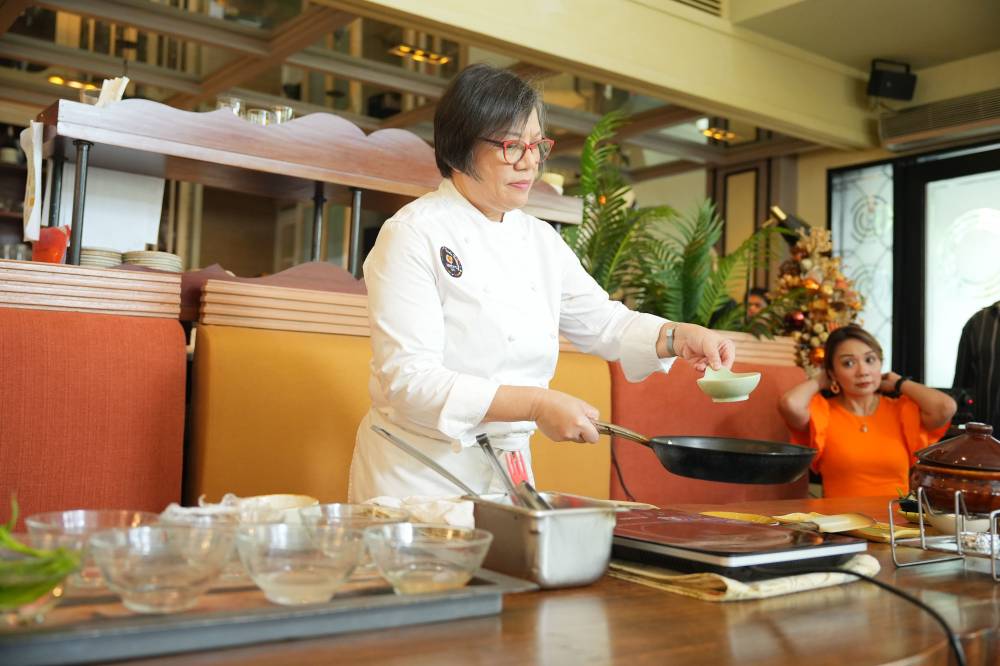
It’s a story Vicky-Rose Pacheco knows all too well.
Aspiring entrepreneurs, usually fresh retirees, decide to take their years’ worth of savings and make a stab at—of all possible options—the food business. They put up the restaurant or quaint little cafe of their dreams fueled by the simple belief that, if they serve good food, people will surely come.
If only it were as simple as that.
One day, an essential kitchen equipment conks out. Your supplier runs out of stocks. A staff member you had trained and invested in suddenly stops showing up. Before you know it, you’ve burned through your hard-earned money just a couple of months after opening.
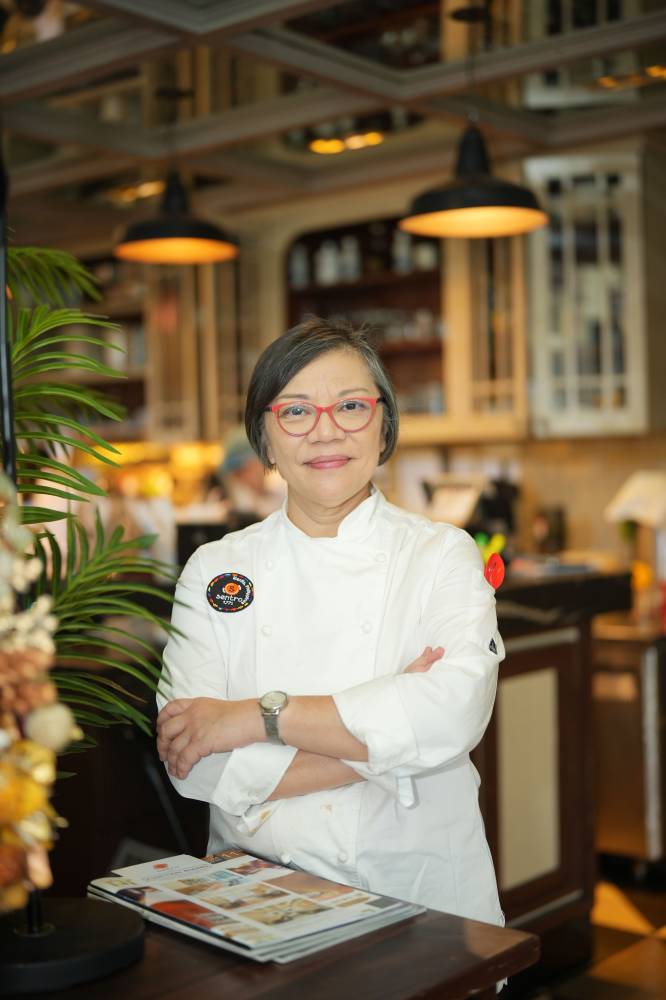
“I don’t know why people want to open a restaurant,” Pacheco wondered out loud in a recent chat with Lifestyle, shortly after a cooking demo of Sentro 1771’s signature dishes at the Filipino restaurant’s Capitol Commons branch.
“Diyos ko, if you have the money, don’t do it!”
Pacheco, the chief operating officer and executive chef of the 1771 Group of Restaurants, isn’t being a party pooper. It’s just that, so often, so many people readily give in to the allure of owning a restaurant without knowing what the process actually entails.
Food isn’t even half the battle. “It’s just a fifth, I would say. A big chunk of it is marketing and sales,” she said. The rest goes to kitchen management, training, and regulatory compliance. “Before you get, or renew, your permit, you have to have clearance from various offices—food safety, pollution control, etc. It’s a lot of things that aren’t related to food itself,” she pointed out.
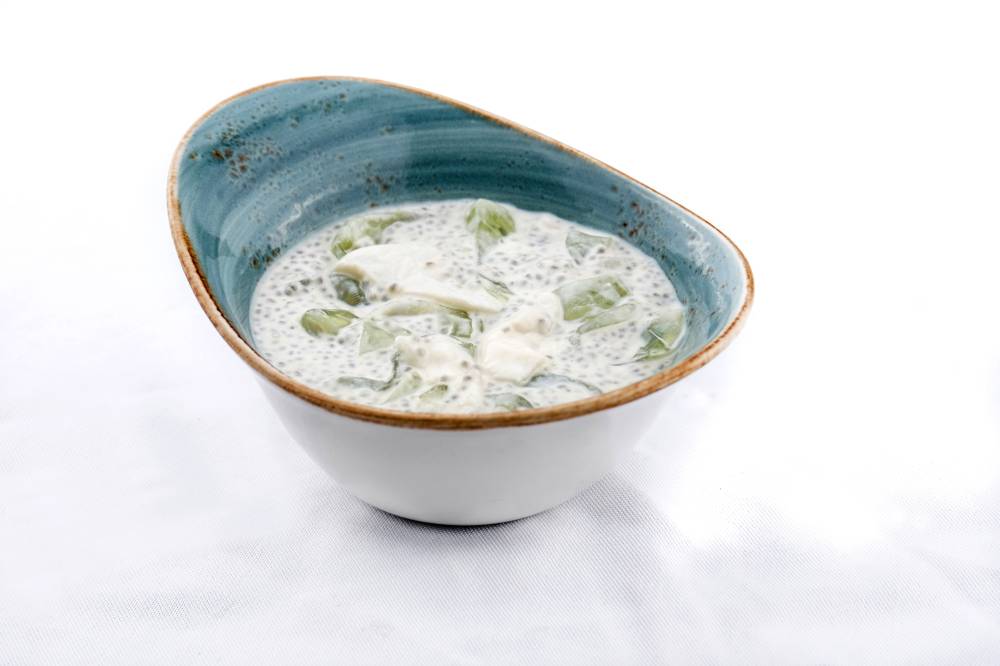
But if cooking and customer service are genuinely your passion, and you’re already dead set on putting up a business, then it’s important, Pacheco said, to have a “mission”—a well to draw inspiration from when the going gets tough.
For the chef, it all boils down to one thing: providing a dining experience that fosters “strong relationships” among people.
“A restaurant business is just a vehicle for that. We eat out because we want to hang out with our friends, because we have relatives to entertain. We want to provide an environment for that. We don’t go out to fight each other,” she said, laughing.

And that kind of environment isn’t meant only for the customers, but for every single person that keeps the kitchen moving. “We have to do our jobs in a sincere and excellent way, because that will help push people to the next level … that will help them grow. And when people grow, they become better people and help society.
“That’s the goal. If you don’t have that, and you’re only after the money, you will get tired of it all,” pointed out Pacheco, who has been running the 1771 group together with chief executive officer Ricky Gutierrez, for the past 25 years.

There’s also something to be said about adaptability and dealing with curveballs that could shake up operations. Case in point: the COVID-19 pandemic, which triggered a domino effect that ultimately altered the dining habits of Sentro 1771’s erstwhile regular customers.
“Their lifestyles have changed. More people are working from home, conducting meetings on Zoom. There are many vacant offices and empty buildings. So, business meetings at restaurants are fewer. People eat out only when there are special occasions, or when they have balikbayans to host,” Pacheco said.
And then there were seemingly small changes that weren’t so small in hindsight, like the Capitol Commons branch losing its parking space behind the building to make way for utility construction. “Some customers now have to park at the mall nearby. And when you’re already at the mall, feeling cool with the air conditioning, tatamarin ka na lumabas,” she said.
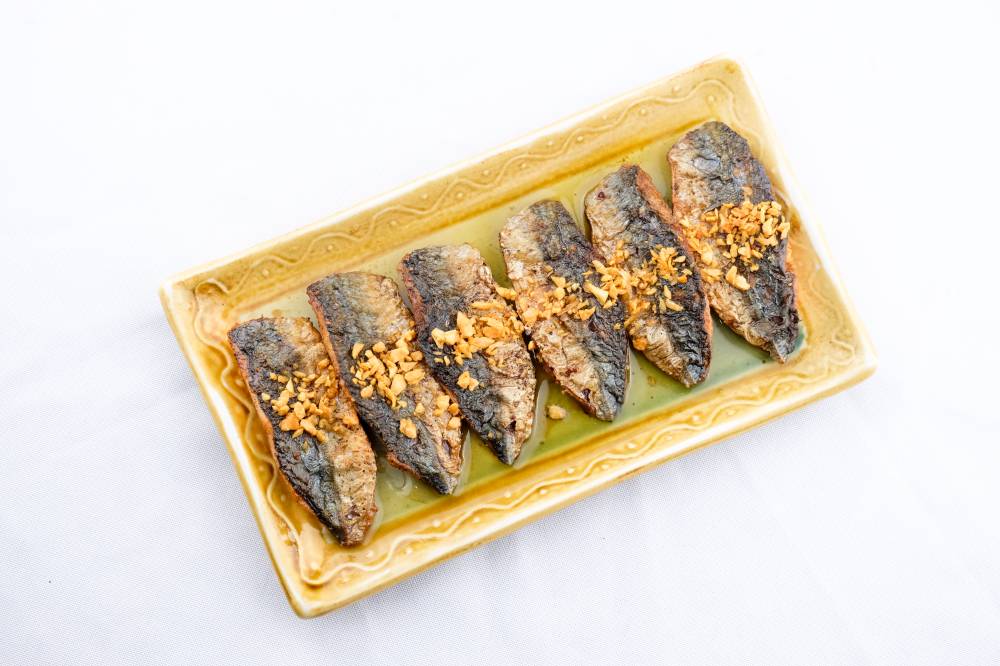
Such changes prompted Pacheco to tweak “the business model a little.” Now, there’s a concerted push to promote Sentro 1771 as an events place. For instance, the aforementioned branch’s layout has been reconfigured to accommodate a larger crowd. Now, the place can host 50 to 100 people, depending on the setup.
“People often look for a place that’s bright and spacious, and we have that. But there used to be a fixture in the middle that prevented us from being more flexible for different types of events. That was a turnoff to customers, so we had it removed,” she said.
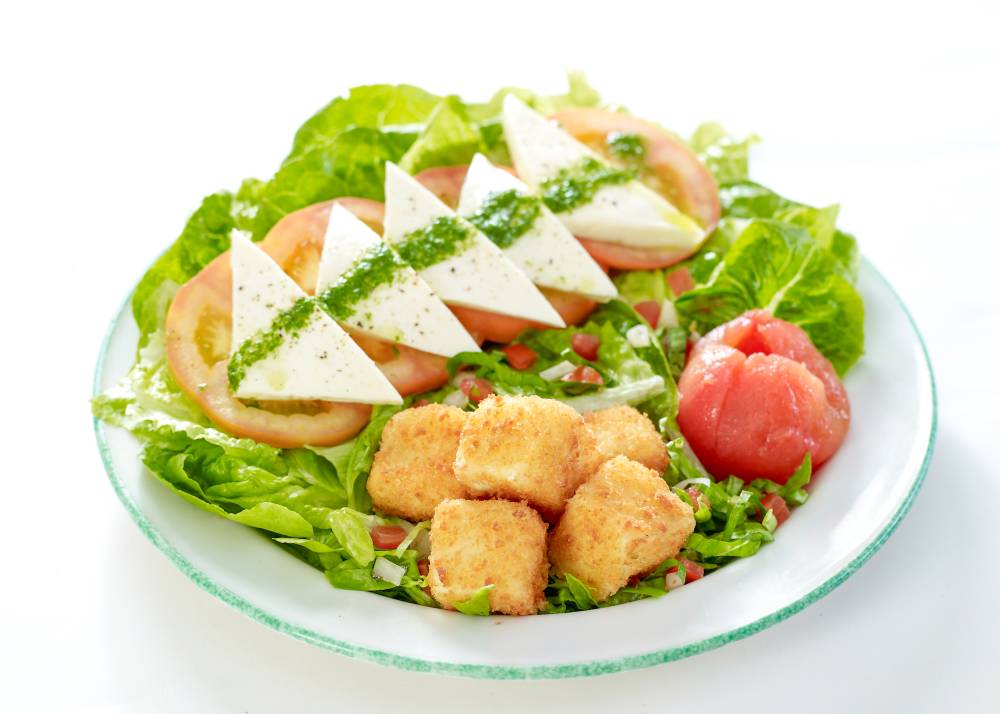
Pacheco also spruced up the restaurant’s interiors, hanging paintings by the late visual artist Allan Cosio on its bare walls. “I want a well-appointed place. I want the ambience to include original artworks—I don’t want those printed things with photos of dishes,” said the chef, who’s as particular about the things she doesn’t like as she is about the things she likes.
But if there’s one thing that hasn’t changed, it’s the restaurant’s pièce de résistance. And when you say Sentro 1771, the first thing that comes to mind, of course, is its famous Corned Beef Sinigang.
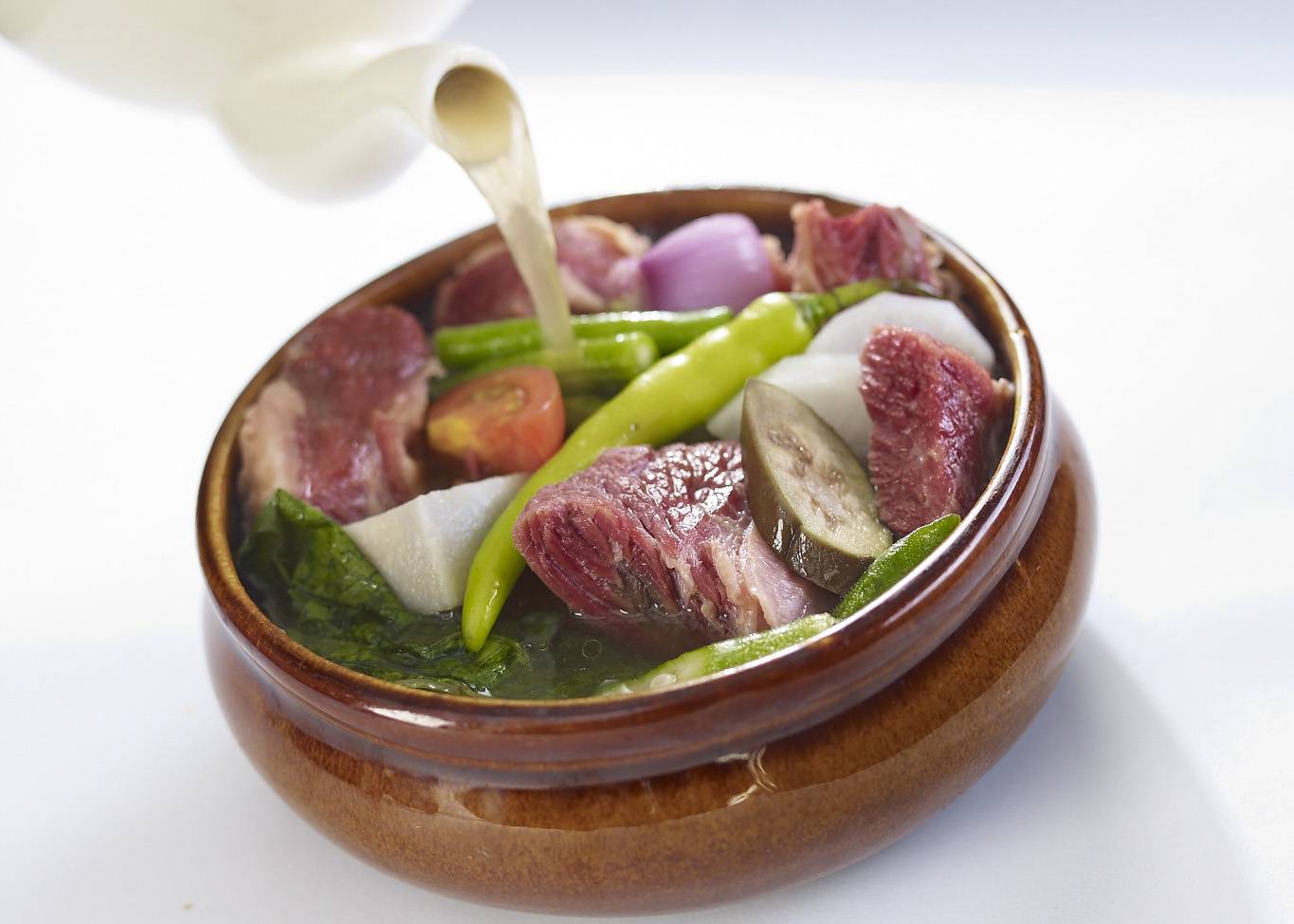
I can’t remember the last time I had the dish, but the bowl served during the lunch Pacheco hosted did taste like how I remembered it. The vegetables were crisp, served in reasonably sized cuts and portions, so as not to crowd the ceramic pot it was served in.
The soup doesn’t punch you in the face, but it was clean-tasting and sufficiently sour, enhancing—and not overpowering—the delicate umami flavors of the home-cured boneless beef shanks.
“The recipe is still the same. Only the cuts of meat have changed; I used to put buto-buto (ribs),” she said. “I think it has remained popular all these years because sinigang is a complete dish—it has soup, vegetables and meat. Buhay ka na!”
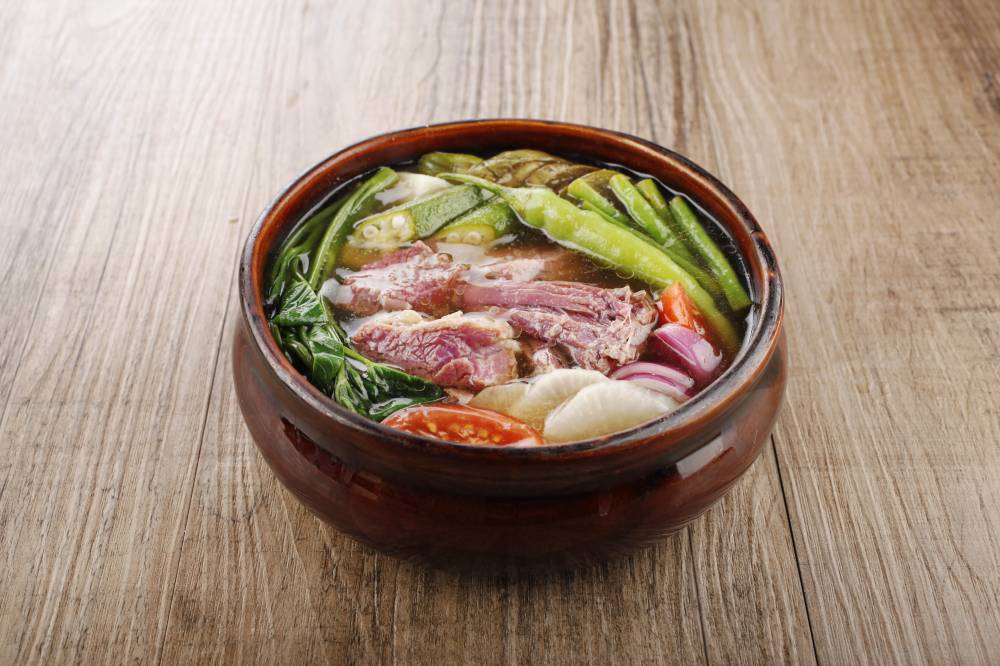
The sinigang arrived with an equally scrumptious supporting cast of longtime house favorites: the Rated GG (galunggong fillets fried in garlic oil), Fresh Smoked Fish Spring Rolls, Macau Chorizo Cheese Tidbits, and Tomato Kesong Puti Salad.
For dessert, we had the Coffee Pie cheesecake and the Fried Suman and Mangoes drizzled with coconut jam. Our favorite, however, was the Buko Chia Salad, whose mix of pandan-infused gelatin strips and chia seeds made for a playful bite and mouthfeel.
There are items that are no longer on the menu (like the Crispy Drunken Shrimps) and new ones that took their place (Bangus with Calamansi Butter, Crispy Kangkong Rice, among others). But just the same, they’re bound by a common thread: Pacheco’s appetite for doing something familiar in ways that aren’t.
“I don’t like to ride on trends. I think of dishes that aren’t in other restaurants,” she said. “I stay true to my concept. Or better yet, I try to create my own category.”